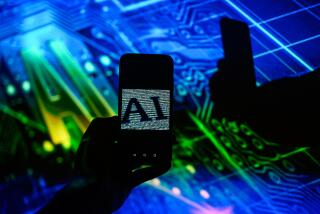BOOK REVIEW : Human Shape of Robotic Things to Come : IN OUR OWN IMAGE: Building an Artificial Person, <i> by Maureen Caudill,</i> Oxford University Press, $22.50; 228 pages
- Share via
The robots are coming, the robots are coming. And they’re not only going to replace truck drivers, fry cooks and nuclear power plant operators, says author Maureen Caudill, they’re going to create a moral dilemma as profound as slavery did.
As early as the year 2000, Caudill says, engineers will be building robots that look, talk and act like humans. Besides being tireless, uncomplaining workers, these “androids” will even develop individual personalities, she says, and feel joy and pain. Some will serve as ever-ready, exuberant, safe sex partners. In brief, they’ll be better than we are.
Well, maybe. Not long ago, after all, the Wall Street Journal reported that General Motors’ new robot paint sprayers were painting each other rather than the cars on the assembly line. And UPI reported that one of the items stolen in a burglary in Arlington, Va., was an anti-theft robot the size of a garbage can that had been programmed to shout, “Warning, intruder! I have summoned the police!”
Nevertheless, Caudill insists that U.S. residents prepare themselves for sweeping change ushered in by mechanical people. For her, the most pressing question is: What should our moral and legal obligation be to these human-like “androids”? Should they be considered alive? Could a human who switched one off be accused of murder? What if an android caused the death of a human?
For the author, who dedicates her book to the memory of “Star Trek” creator Gene Roddenberry, these are serious questions--not least because, in her view, androids could evolve to the point of controlling their own evolution and reproduction. They could even someday rival humans for control of the Earth.
Despite the sci-fi ring of her prophecy, Caudill is no hand-waving millenarian. A consultant to industry, she has co-authored two books, published by MIT Press, on the fast-growing field of neural networks.
Neural networks, like computers, manipulate electrical signals to solve problems. But unlike computers, they don’t use digital logical processes, or so-called artificial intelligence. Instead, they imitate the brain’s more randomly associative electrochemical activity. Like brains, too, neural networks can be “trained” through an electronic version of Pavlovian reinforcement. And neural networks can teach themselves to improve their performance in executing a task.
Android brains will contain both computers and neural networks, Caudill says. Neural networks will make the robots human-like by providing the intuitive component of their thought processes.
But should the androids’ ability to seem human-like make them, in legal terms, people? Should it burden them with the same responsibilities and entitle them to the same rights that people enjoy?
Instead of answering these questions directly, Caudill reviews the present state of robotics and lets the reader decide. “In Our Own Image” marches resolutely through the latest research in robot vision, locomotion, hand and arm movement, task learning, problem solving, understanding and speaking human language, and sensing the environment.
Caudill is a lucid writer, and “In Our Own Image” achieves a commanding perspective on the field of robotics. But she shows the reader too few examples of working robots.
She mentions, most memorably, a German machine that can guide a car at near-highway speeds, a Japanese robot that can read sheet music and play an organ, and some foot-long robotic ants that follow people around a room at MIT. But she devotes most of the book to abstract engineering strategies and to describing biological systems that engineers try to imitate in their designs.
While Caudill is a first-rate explainer of the principles of robotics, her advocacy for androids can be chilling. She suggests, for example, that robots will make excellent nannies, teacher’s aides and hospital orderlies. Those for whom such a prospect holds scant appeal can take comfort, though, in the famously poor record of technological prophets--their predictions have a way of not coming true. Odds are that androids will remain 10 years off, well into the next century.
More to Read
Sign up for our Book Club newsletter
Get the latest news, events and more from the Los Angeles Times Book Club, and help us get L.A. reading and talking.
You may occasionally receive promotional content from the Los Angeles Times.










